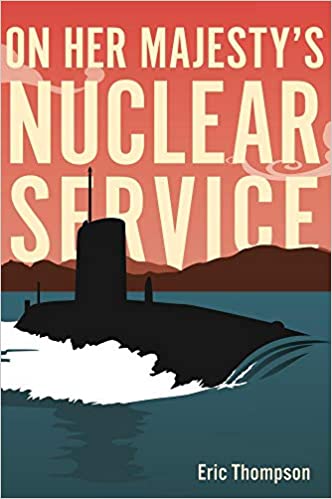
Reviewed by Rear Admiral William J. Holland, USN (RET).
Commodore Thompson’s wonderful memoir opens by describing a major steam leak in a submerged submarine where he was what we call the Engineering Officer of the Watch (EOOW). This is as scary and stressing an event as can happen in a nuclear powered submarine. How he solved the problem was ingenious and not, to my knowledge, in the Reactor Plant Manual. But this episode, while exciting and satisfying for those of us who have occupied such positions, does not set the tenor for this engrossing memoir.
Commodore Thompson was designated an engineering officer from his earliest assignments: poor eyesight disqualified him as a seaman (line) officer. His descriptions make clear the roles of engineers in the Royal Navy and the dichotomy between the helmsmen and the propulsors. The division between seamen and engineers in the RN and the melding of both in the USN has been a long standing source of disputation between the two services. While the US Navy in most areas adopted the practices of the Royal Navy, in this particular aspect of naval officer assignments and expectations, the two services are vastly different. Thompson does not open the issue but his memoir shows how much the career path and duty assignments of the RN (E) with its regular assignment ashore or staff, technical dimensions, graduate schooling and responsibilities differ from the American model. His most telling remark, “In a nuclear boat, Engineers were no longer bit players”, demonstrates that, unlike in US submarines, RN Commanding Officers did not play in the back half of the boat.
Commodore Thompson was not uniformly successful in his progression to senior ranks. He relates with some embarrassment tales of being summarily dismissed, ordered off ship, fired, or otherwise faced with failure. His story exemplifies the adage of ”Bloom where you are planted”. In several cases finding himself without an assignment, he seized the opportunity to enter specialties that seemed to be without future career promise but which became vital to the Royal Navy’s success and proved to be significant opportunities for his personal advancement. Finding himself significantly behind his contemporaries, he carved a niche as a Weapons Engineer requesting assignment as analyst in the Submarine Tactics and Weapons Group (STWG), a “career dead end”. Rejecting the glowing reports of the Tigerfish Mod 1 from the manufacturer (Marconi), he arranged, conducted and analyzed actual trial firings. The results of his analysis were a change in tactics and in the technology of the follow-on Mod2 torpedo. In a second “dead end” he became the RN’s first Silencing Officer, just as submarine tonals became important.
There is a new story in every chapter as he covers life and reality in the Royal Navy and its “secretive and somewhat subversive” submarine service. He combines historical recollection, personal insights, policy reviews, technical discussions, personnel evaluations wth episodic humor. Replete with British witticisms, his social commentary reveals the extent to which family connections foster paths to command and flag. The smaller officer corps in the Royal Navy and particularly in the even small subset in submarines makes personalities more vivid and lasting. His breadth of observations extends to the breeding habits of gannets.
Though Thompson was never in command of a ballistic missile submarine, he discusses and endorses the role and necessity of the nuclear deterrent, its value in peace keeping and the political importance of its maintenance. He describes in some detail the “Letter of Last Resort” to each SSBN Commanding Officer. This is a personal instruction from the Prime Minister to the Commanding Officer to be executed if all normal communications are lost. His discussion is the most revealing of any description that this reviewer, who never served in an SSBN, has ever read.
This memoir is not just a personal tale but a chronicle of insights and activities during the period of his service (1961-1998). Both witty and serious, his social commentary is as insightful as those of a maritime nature. This book is not just easy but fun to read. The language alone is worth the trip. At the end, readers with submarine experience will be comfortable “knowing’ Commodore Thompson; those without dolphins will have more than a taste of that experience.
On Her Majesty’s Nuclear Service by Commodore Eric Thompson, RN, OBE Oxford and Philadelphia CASEMETE Publishing, 2018.
Reviewed by Rear Admiral William J. Holland, USN (RET).
Purchase on Amazon today: amzn.to/3fZMMzO

